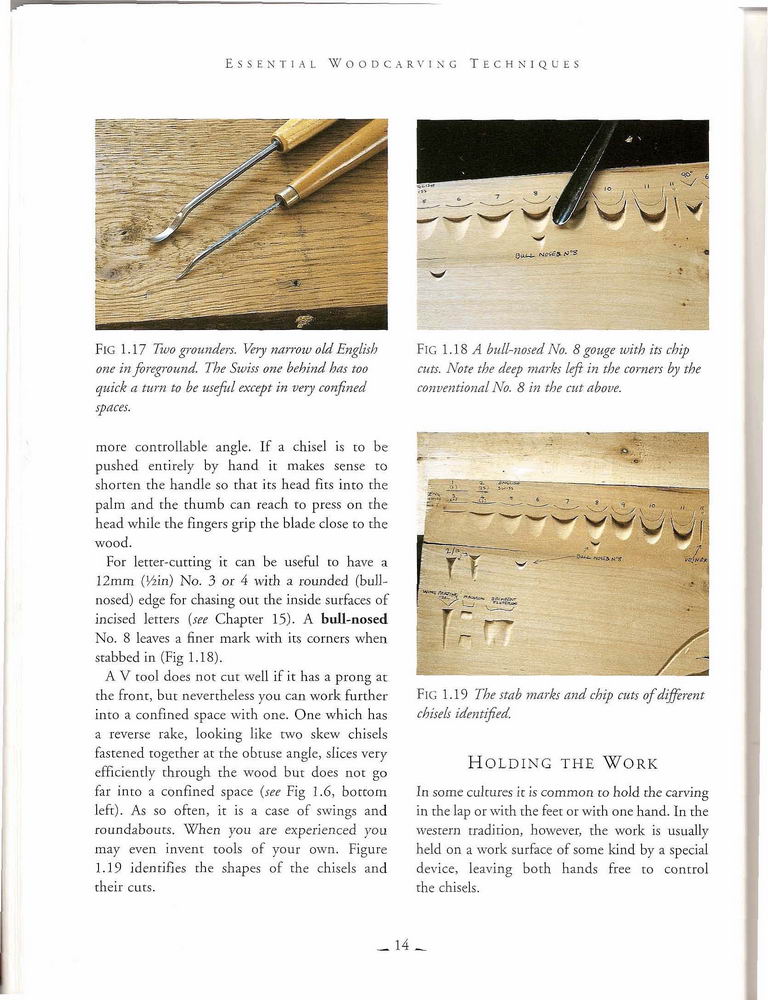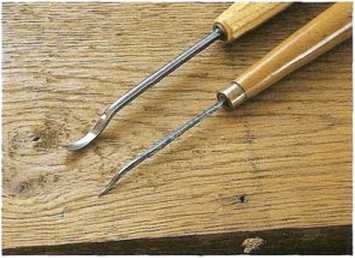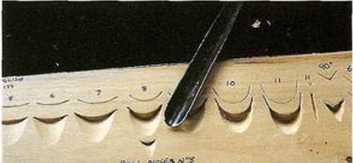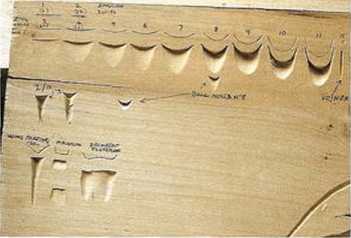essent╩rving░14

Essential Woodcarvixg Techniques


W
Fig 1.17 Ttoo grounders. Very narrow old English one in foreground. The Swiss one behind has too cjuick a tum to be useful except in very confined spaces.
morę controllablc anglc. If a chiscl is to be pushcd entirely by hand it makes sense to shortcn the handle so that its head Fits into the palm and the thumb can reach to prcss on the head whiłc the fingers grip the blade close to the wood.
For lettcr-cutting it can be useful to have a 12mm {Vtin) No. 3 or 4 wirh a rounded (bu)l-nosed) edge for chasing out the insidc surfaccs of incised letrers (see Chapter 15). A bull-nosed No. 8 lcaves a finer mark with its corners when stabbed in (Fig 1.18).
A V tool does not cut well if it has a prong at the front, but ncvcrtheless you can work furthcr into a confined spacc with one. One which has a reverse rake, looking like rwo skcw chisels fastened togcther at the obtuse anglc, slices very efficiently through the wood but does not go far into a confined space {see Fig 1.6, botcorn left). As so often, it is a case of swing? and roundabouts. When you are expcricnced you may even invent tools of your own. Figur─Ö 1.19 idenrifies the shapes of the chisels and their cuts.
Fig 1.18/1 bull-nosed No. 8 gouge with its chip cuts. Not─Ö the deep marks left in the corners by the conuentional No. 8 in the cut aboue.
o

Fig 1.19 The stab marks and chip cuts of different chisels identified.
Holding the Work
In somc culcurcs it is common to hołd the carving in the lap or with the feet or with one hand. In the western tradition, however, the work is usually held on a work surface of some kind by a special device, leaving both hands free to control the chisels.
_ 14 _
Wyszukiwarka
Podobne podstrony:
essent?rving?84 Essential Woodcarving Techniques Fig 7.7 This is how a piece of card would look if f
essent?rving?98 Essential Woodcarving Techniques Fig 9.1 Various lines. The one on the left Incks in
essent?rving?52 Essential Woodcarying Techniques Fig 14.3 Mov mg water. Fig 14.4 Drawings devełoping
essent?rving?18 Essen tul Woodcarning Techniques Fig 1.29 A bench holdfast in use. Fig 1.28 A univer
essent?rving?30 Essen ti al Woodcarving Techniques Fig 2.4 A piece of Southern yeUow pine. The dark
essent?rving?66 Essen ti al Woodcarvixg Techniques Fig 5.1 Oak leafstudies by a student (Howard Spie
essent?rving?10 Essentiai. Woodcarying Techniques Makes of Tool Maker/brand Country Edge-
essent?rving?28 Essential Woodcarving Techniques Phloem or bast Bark Wood or xylem Roots anchor the
essent?rving?56 Essential Woodcarvixc Techniques Critical factors in cutting mouldings are the sizes
essent?rving?70 Essential Woodcaryinc Techntiques Fig 5.11 The top surface of the leaffinished, with
essent?rving?14 ESSENTIAL WOODCARNING TECHNIQUES 1 Base flattened before beginning carving. downward
essent?rving?48 Essential W o o d c aR v
Przegl─ůd Geologiczny, vol. 55, nr 12/1, 2007 Fig. 17. ÔÇťBam├│wko-Mostno-BuszewoÔÇŁ (BMB) oil-gas field i
essent?rving?68 Essen tial Woodcarving Techniques FlG 15.16 The fint cut into the serif on an M. Fig
essent?rving?34 Essen tial Woodcarying Techniques softwoods are evergreen and hardwoods are dcciduou
essent?rving?40 Essen tial Woodcarying Techniques FlG 2.20 Arrow Crosstree (Dick Onians), carued in
essent?rving?48 Essen tiał Woodcarving Techxiques Fig 3.5 From the bot tom: two correct chip cuts; t
essent?rving?50 Essen tial W o o d c a r vin g Techniques Fig 3.11 Making the stab aa at too shallow
wi─Öcej podobnych podstron